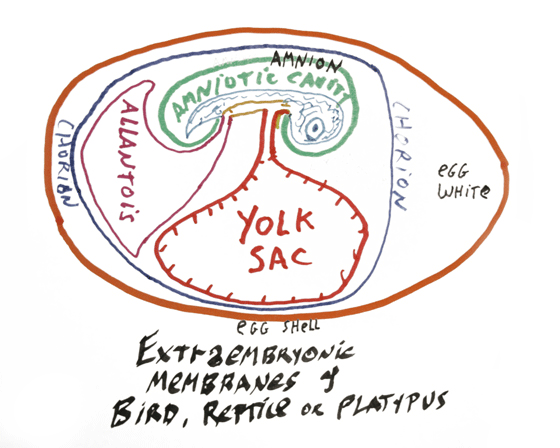Extra-embryonic membranes
Reptiles evolved four extra-embryonic membranes:And then birds and mammals inherited all four of them.


Chorion: Ectoderm & Mesoderm
-
Surrounds all the rest (of the embryo and the other e.e. membranes
Is in direct contact with the uterus (in mammals)
[of course, mammals are the only vertebrates that have uteruses]
Extraembryonic membranes: (in teleosts) enveloping layer, yolk syncytial layer (in reptiles birds and mammals) chorion, amnion, "bag of waters", yolk sac, allantois, extraembryonic coelom. The chorion and amnion develop from epidermal ectoderm and lateral plate mesoderm. The yolk sac and allantois develop from endoderm and lateral plate mesoderm. Amnion: Ectoderm & Mesoderm
The space enclosed inside the amnion is the Bag of Waters.
Yolk sac: Endoderm & Mesoderm
is an outpocketing of the middle of the digestive tract
(Stores yolk for food)
Allantois: Endoderm & Mesoderm is an outpocketing of the hindmost part of the digestive tract (Stores urine) (very well-developed blood vessels)
Birds and mammals inherited all 4 of these extra-embryonic membranes.
("extra" in this sense means "outside", rather than "more than usual")
The umbilical cord connects all four of these to the body itself,
and contains two arteries and one vein.
(Urine can sometimes squirt out of the belly button in young children)
Turtles, snakes, lizards sometimes hatch with a large yolk sac protruding from them. This will be physically retracted into the body in a few days; don't cut it off!
Many species of snakes incubate their eggs inside the uterus, instead of laying eggs.
Most reptiles have flexible "leathery" egg shells. Indentations in reptile egg shells often push on early embryos, which can result in two-headed offspring.
In mammal embryos, the body develops out of part of the inner cell mass. The large sphere of cells ("the trophoblast") develops into the chorion.
Mammal embryos digest a pathway into the wall of the uterus "endometrium" and crawl down into it until completely surrounded by uterine cells. (This digesting & burrowing is called "implantation")
It digests through uterine tissues, including blood vessels,
so that blood flows directly across the part of the chorion where the allantois is just inside.
Advantage: better permeability
Disadvantage: more bleeding & difficulty at the time of birth
Pigs, horses and many other kinds of mammals have much less of this tissue removal.
Advantage: less damage to uterus at birth
Disadvantage: worse permeability; urine actually gets stored in allantois
Note: There is no kind of animal in which the circulatory system of the mother ever connects directly to the circulatory system of embryos (like a trailer hook-up).
Although that would seem to make sense; and some very weird methods of nutrient transfer have evolved. For example, live-bearing teleosts have placenta-like connections between the ovary of the mother and the perichondrium of the embryo, and in some species of sharks one of the developing embryos bites off pieces of other embryos and devours them. Julian Lombardi was the world's expert on these kinds of phenomena, wrote a whole large book on it, and for years was a member of this department and taught many courses.
He proposed a hypothesis that early live-bearing reptiles may have been the first to evolve the chorion, amnion etc. Previously, scientists had assumed (for no particular reason) that the reptile & bird type of egg and the Primitive Streak & Hensen's Node type of gastrulation must have first evolved in egg-laying primitive reptiles &/or advanced salamanders. If eggs fossilized better & more often, then we might know for sure.
Three alternative causes of identical twinning: If both twins are enclosed in the same amnion, then there were 2 primitive streaks in the same inner cell mass. (and they will also be inside the same chorion)
If both twins are together inside the same chorion, but each separate in their own two amnions, then they developed from two separate inner cell masses, inside the same trophoblast.
If twins are both in their own separate chorion, then they developed from separate trophoblasts, and might not be identical twins.
Incidentally a very great immunological discovery was accidentally made by using skin grafts to (try to!) distinguish between cattle twins that were genetically identical versus which were "fraternal" twins.
Researchers expected that only non-identical twins would "reject" organ grafts from each other. But immune tolerance VERY unexpectedly developed in non-identical twin cattle. Their immune systems didn't attack each other! Can you figure out, or guess, why not? (Note: this doesn't occur in human twins, for some unimportant reason.)
